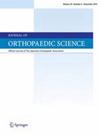Morphological and histological evaluation of the tendon-bone junction in porcine shoulders to create a rotator cuff tear and repair model
IF 1.5
4区 医学
Q3 ORTHOPEDICS
引用次数: 0
Abstract
Background
This study aimed to morphologically and histologically examine whether pig is useful as models for rotator cuff tear (RCT).
Methods
The morphology of the scapula and humerus bones was evaluated by taking X-ray and three-dimensional computed tomography (3D CT) scans of the right shoulders of five female pigs (age: 4 months). The rotator cuff (RC) footprint at the humeral insertion of these was observed and its shape was measured. Next, they underwent general anesthesia and an acute rotator cuff tear/rotator cuff repair (RCT/RCR) model was created using a deltoid split approach. Four weeks after surgery, the animals were euthanized, the shoulder joints were harvested, and the repaired RC was evaluated by hematoxylin and eosin staining and toluidine blue staining.
Results
The scapula of the pig had a vestigial acromion, in contrast to that in humans. The supraspinatus and infraspinatus tendons were connected so as to overlap each other and attached to the postero-superior part of the greater tuberosity. These tendons were located extra-articularly, separate from the joint capsule. The average antero-posterior length of the foot print was 17.4 ± 0.7 mm on the medial margin and 19.1 ± 2.2 mm on the lateral margin. The maximum medial-to-lateral width of it was 5.1 ± 0.5 mm. In all RCT/RCR models at 4 weeks after surgery, the repaired RC compound tendon was visually confirmed to be continuous with the footprint. Histologically, it was confirmed that regeneration of the four-layer structure of the bone-tendon junction had occurred.
Conclusion
Porcine supraspinatus and infraspinatus attachment to the greater tuberosity have a structure similar to that of sheep and dogs, which is advantageous for creating the RCT/RCR model. It might be used for future in vivo studies of shoulder joint diseases.
The Translational Potential of this Article
Pigs could potentially serve as a viable model for rotator cuff tears.
对猪肩肌腱-骨连接处进行形态学和组织学评价,建立肩袖撕裂和修复模型。
背景:本研究旨在形态学和组织学上检验猪是否可作为肩袖撕裂(RCT)模型。方法:对5头4月龄母猪右肩进行x线和三维CT扫描,观察其肩胛骨和肱骨形态。观察肱骨插入处的肩袖(RC)足迹并测量其形状。接下来,他们接受全身麻醉,并使用三角肌分裂入路创建急性肩袖撕裂/肩袖修复(RCT/RCR)模型。术后4周,对动物实施安乐死,摘取肩关节,采用苏木精、伊红染色和甲苯胺蓝染色评价修复后的RC。结果:猪的肩胛骨有一个退化的肩峰,与人的肩胛骨不同。冈上肌和冈下肌相互连接重叠,并附着于大结节后上部。这些肌腱位于关节外,与关节囊分离。足印前后平均长度内侧缘17.4±0.7 mm,外侧缘19.1±2.2 mm。最大中外侧宽度为5.1±0.5 mm。在术后4周的所有RCT/RCR模型中,目测证实修复后的RC复合肌腱与足印连续。组织学上证实骨-肌腱连接处的四层结构发生了再生。结论:猪冈上肌和冈下肌附着于大结节的结构与羊和狗相似,这有利于建立RCT/RCR模型。它可能用于未来肩关节疾病的体内研究。这篇文章的转化潜力:猪有可能作为肩袖撕裂的可行模型。
本文章由计算机程序翻译,如有差异,请以英文原文为准。
求助全文
约1分钟内获得全文
求助全文
来源期刊

Journal of Orthopaedic Science
医学-整形外科
CiteScore
3.00
自引率
0.00%
发文量
290
审稿时长
90 days
期刊介绍:
The Journal of Orthopaedic Science is the official peer-reviewed journal of the Japanese Orthopaedic Association. The journal publishes the latest researches and topical debates in all fields of clinical and experimental orthopaedics, including musculoskeletal medicine, sports medicine, locomotive syndrome, trauma, paediatrics, oncology and biomaterials, as well as basic researches.
 求助内容:
求助内容: 应助结果提醒方式:
应助结果提醒方式:


